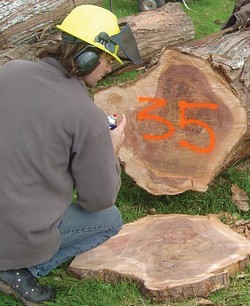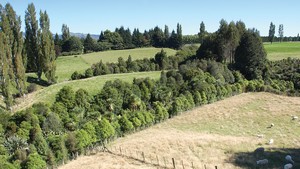Celebrating the year’s achievements
The past financial year has been jam-packed with the development of clever gadgets to measure wood quality, exciting scientific discoveries of valuable chemicals hiding in bark and other tree tissues, and the arrival of new expertise in the areas of human factors, biotransformation and clean technologies.
Research indicates that the future will increasingly be driven by the need to address environmental restraints such as water quality and climate change; and that forestry will expand to meet this demand with a greater emphasis on integrated land use that will lead to more forest derived products in supply chains, and regional job creation. We’ve been working hard on a range of projects to increase the profitability of the forestry industry and expand its potential as a versatile building block of the future. Here are some of our achievements this year:
Developing new industries for Northland
 We have been working with several organisations to explore the feasibility of a new industry based on Northland’s extensive tōtara resources, which could add another dimension to the forest products industry and the regional economy. Studies indicate there may be over 200,000 hectares of naturally regenerated tōtara growing on private land in the region.
We have been working with several organisations to explore the feasibility of a new industry based on Northland’s extensive tōtara resources, which could add another dimension to the forest products industry and the regional economy. Studies indicate there may be over 200,000 hectares of naturally regenerated tōtara growing on private land in the region.
“Tōtara is a resilient species that grows vigorously in various soil types under a variety of conditions,” says indigenous forest specialist Greg Steward. “Until recently, tōtara has been considered of little economic value, however it produces attractive, straight grained wood and durable heartwood that is inherently resistant to fungal degradation.
“Northland could really benefit from a new wood products industry based on this resource. The development of high-value wood products to replace imported products would see the generation of new business opportunities along the value chain, as well as the commercial investment in a culturally important indigenous species.”
Greg says that while the growth rate of tōtara is unlikely to reach that of fast growing exotics such as radiata pine, our scientists are confident there is an opportunity to increase productivity of the species.
Boosting forestry productivity
 Scion is in its second year of the 6-year Growing Confidence in Forestry’s Future programme, a joint programme between industry, Scion and MBIE aimed at boosting the productivity and economics of forestry. Our scientists have already made a number of important achievements, particularly in calculating the gap that exists between current and potential productivity.
Scion is in its second year of the 6-year Growing Confidence in Forestry’s Future programme, a joint programme between industry, Scion and MBIE aimed at boosting the productivity and economics of forestry. Our scientists have already made a number of important achievements, particularly in calculating the gap that exists between current and potential productivity.
“We’re using a combination of modelling studies and historical data to examine ways in which forest growers can increase productivity in a sustainable manner without compromising wood quality,” says science leader Dr Peter Clinton. “The programme is building on the legacy of trials and growth monitoring plots, some of which were established almost 40 years ago, to study the effects of factors such as silviculture, genetics, nutrition and site disturbance on tree growth and wood properties.
“Recent data from these historic trials have provided new insights into the drivers of productivity, and the impacts of forest management activities on wood quality and sustainability. This information is already helping forest growers better understand the existing forest resource and to develop management regimes for stands that are being replanted.”
New information on the internal characteristics of trees will soon be available through Scion’s purpose-built robotic disc scanner. It will enable us to better understand the variability in wood properties that exists within and between trees, and the consequences of this variation on end products such as sawn timber.
Forests provide more value than timber and wood fibre
 There is a growing realisation of the environmental and social benefits provided by forests over and above timber and wood products, including those relating to climate change.
There is a growing realisation of the environmental and social benefits provided by forests over and above timber and wood products, including those relating to climate change.
“This year, our research team has made strides in evaluating ecosystem services, such as carbon sequestration, water quality improvement, avoided erosion and increased biodiversity,” says resource economist Dr Richard Yao. “In a recent catchment-level study, we showed that converting 320 hectares of dry stock farms to exotic forestry could provide a net gain in the value of ecosystem services of about $9,000 per hectare per year. This would add almost $3 million to the ecosystem services value of the catchment.
“The development of methods to estimate the non-market value of ecosystem services, such as recreational walking and biodiversity, means these services can now be better represented in land management discussions alongside those with market values.
“This provides a comprehensive framework for council land managers that will ensure the full potential of their catchments are achieved in the long term.”
Easier to process softwood
Scion’s wide research brief takes it well beyond tree growing. Biotransformation is ground breaking work, and Scion scientists teamed up with the University of Wisconsin-Madison to make radiata pine and other softwoods easier to process into valuable feedstock for the pulp, paper and biofuel industries.
Metabolic engineering allows biotechnologists to introduce a desirable new pathway or trait into a population where it is not normally, or readily available. In this case, our scientists have shown it’s possible that we can engineer softwoods, such as radiata pine, to produce easier to process hardwood-like lignin while retaining their outstanding fibre properties.
“Easier to process softwood has both economic and environmental benefits,” says research leader Dr Glenn Thorlby. “Needing less energy, the pre-treatment process will be faster, more efficient and less wasteful, yielding improved feedstock for pulp, paper and biofuel industries.”
Achieving environmental equilibrium with timber
 Scion’s Built Environment Team has developed a strategy to address climate change by using timber-based building materials. Urban Equilibrium aims to maintain the balance between humanity and the natural environment by using building materials that sequester and store carbon, and help reduce greenhouse gas emissions.
Scion’s Built Environment Team has developed a strategy to address climate change by using timber-based building materials. Urban Equilibrium aims to maintain the balance between humanity and the natural environment by using building materials that sequester and store carbon, and help reduce greenhouse gas emissions.
“With the move to more, and larger cities, it’s becoming more important for the built environment to balance its greenhouse gas emissions,” says sustainable architect Andrea Stocchero. “We can calculate the amount of carbon sequestered within the built environment starting with the volume of timber used in solid timber buildings.
“As an exemplar, we applied the principles of urban equilibrium using solid and engineered wood construction technologies, to Auckland’s forecast urban development over the next 30 years. This showed that Auckland Council could achieve their carbon emissions reduction target 25 per cent faster than planned.”
The ultimate biorefineries
 Our researchers are making some unexpected discoveries about bark and other tree tissues. Scion’s transformative wood dewatering technology is used to extract water and bio-chemicals from radiata pine to produce high-value, modified wood products. We recently branched out into other species, and other parts of the tree that traditionally go to waste – such as bark, leaves and needles, using a similar technology.
Our researchers are making some unexpected discoveries about bark and other tree tissues. Scion’s transformative wood dewatering technology is used to extract water and bio-chemicals from radiata pine to produce high-value, modified wood products. We recently branched out into other species, and other parts of the tree that traditionally go to waste – such as bark, leaves and needles, using a similar technology.
“The results have been surprising, and very exciting,” says research leader Dr Stefan Hill, who has been using nuclear magnetic resonance and other analytical techniques to test the chemical make-up of the extractives recovered.
“We identified a group of highly functional chemicals that were previously not easily obtainable. With a high percentage of bark and other tissue being burned or dumped, this means valuable chemicals are currently going to waste.
“These discoveries offer exciting possibilities for future ‘whole-of-tree biorefining’ where virtually none of the tree is left behind in the forest and a tree’s entire resources are more fully utilised.”
You can read more about our achievements in Scion’s 2015 Annual Report Highlights, to be published in early October, at www.scionresearch.com/annualreports
